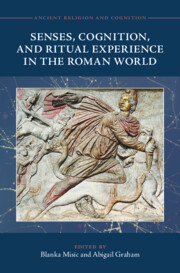Book contents
- Senses, Cognition, and Ritual Experience in the Roman World
- Ancient Religion and Cognition
- Senses, Cognition, and Ritual Experience in the Roman World
- Copyright page
- Contents
- Figures
- Contributors
- Acknowledgements
- Abbreviations
- Introduction Experiencing Rituals
- Chapter 1 Remembering the Rites: Religious Learning Network Model and Transmission of Religious Rituals in the Worship of Nutrices Augustae (Poetovio, Pannonia Superior)
- Chapter 2 The Haptic Production of Religious Knowledge among the Vestal Virgins: A Hands-On Approach to Roman Ritual
- Chapter 3 Haptic Colour: Experiential Viewing in Graeco-Roman Sacred Spaces
- Chapter 4 Nobody Is Gonna Rain on My Parade: Experiencing Salutaris’s Procession As a Ritual Event
- Chapter 5 Objects and Ritual in Egeria’s Fourth-Century Pilgrimage: The Props of My Faith
- Conclusion (Re)Creating Ritual Experiences
- Index
- References
Chapter 5 - Objects and Ritual in Egeria’s Fourth-Century Pilgrimage: The Props of My Faith
Published online by Cambridge University Press: 04 January 2024
- Senses, Cognition, and Ritual Experience in the Roman World
- Ancient Religion and Cognition
- Senses, Cognition, and Ritual Experience in the Roman World
- Copyright page
- Contents
- Figures
- Contributors
- Acknowledgements
- Abbreviations
- Introduction Experiencing Rituals
- Chapter 1 Remembering the Rites: Religious Learning Network Model and Transmission of Religious Rituals in the Worship of Nutrices Augustae (Poetovio, Pannonia Superior)
- Chapter 2 The Haptic Production of Religious Knowledge among the Vestal Virgins: A Hands-On Approach to Roman Ritual
- Chapter 3 Haptic Colour: Experiential Viewing in Graeco-Roman Sacred Spaces
- Chapter 4 Nobody Is Gonna Rain on My Parade: Experiencing Salutaris’s Procession As a Ritual Event
- Chapter 5 Objects and Ritual in Egeria’s Fourth-Century Pilgrimage: The Props of My Faith
- Conclusion (Re)Creating Ritual Experiences
- Index
- References
Summary
Egeria, a late fourth century Christian pilgrim to Jerusalem, describes a dramatic ritual on the morning of Good Friday. This text is remarkable on several counts: it is written by a female, it has an early date (soon after Constantine’s initiatives in establishing Christian pilgrimage) and it provides a wonderfully detailed description of the areas visited in Jerusalem during Holy Week. She and the other pilgrims venerate the wood of the cross, the inscription over Jesus’s head, the horn used to anoint the kings of Israel, and the ring of Solomon. Throughout her account, Egeria stresses the importance of pilgrims being assured of the truth of their faith by encountering physical landscapes and tangible objects. Theatrical studies in dramaturgy and stagecraft affirm the role which props play in helping actors activate memory and achieve a rich performance. This chapter examines the network of symbols in these artifacts using ritual studies, theatre analysis and space and place theory, demonstrating how these objects were used as props in a complex ritual drama, which offered material, sensory and embodied experiences for religious pilgrims.
- Type
- Chapter
- Information
- Senses, Cognition, and Ritual Experience in the Roman World , pp. 167 - 199Publisher: Cambridge University PressPrint publication year: 2024



